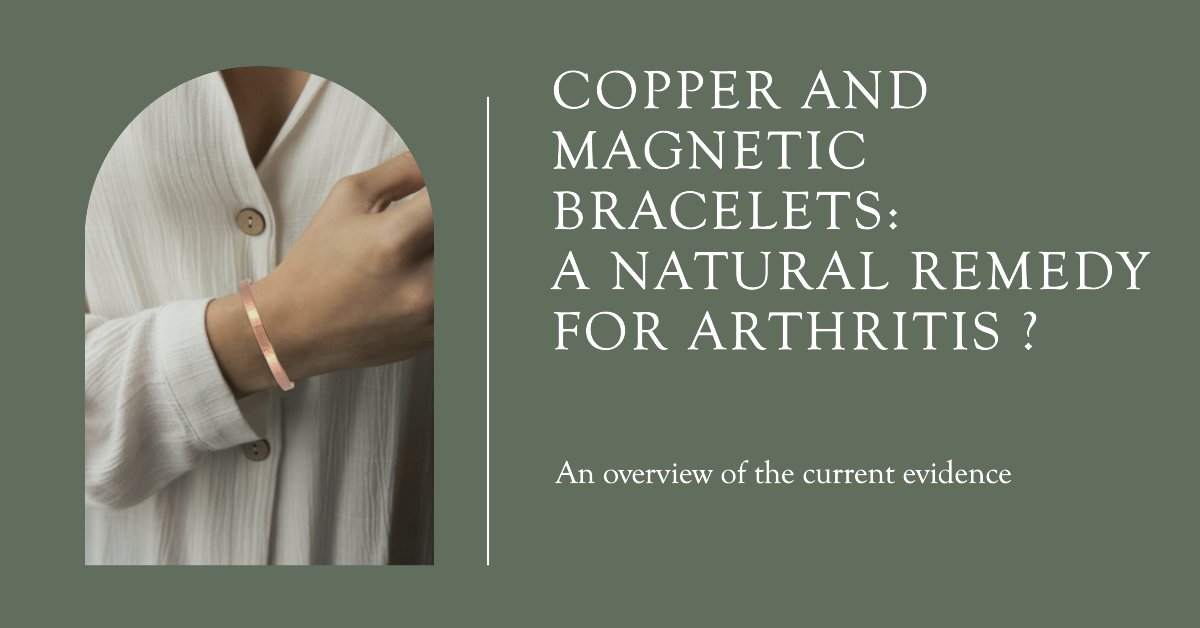Copper Bracelet Health Benefits: Do They Really Help With Arthritis?

Copper and magnetic bracelets are often promoted for their potential health benefits, such as relieving arthritis symptoms like joint pain and stiffness. But do these trendy bracelets actually work? This comprehensive guide examines the evidence on copper and magnetic bracelets for arthritis.
Key Takeaway's on Copper and Magnetic Bracelets for Arthritis
| Aspect | Copper Bracelets | Magnetic Bracelets | Combined Copper & Magnetic Bracelets |
|---|---|---|---|
|
Proposed |
- May minimize inflammation - Could reduce joint pain and stiffness - Compression may improve circulation |
- May encourage blood flow - Could alter nerve impulses and reduce pain - Compression may reduce swelling |
Offers both potential advantages of copper and static magnets |
|
Research |
- Insufficient evidence to relieve arthritis symptoms - No significant difference found in pain, stiffness, or physical function in studies |
- Minimal evidence for improvement in symptoms - Some studies report slight benefits, but larger trials are needed |
Not specifically studied, but combines both approaches |
|
Potential |
- Skin reactions - Hand staining - Possible nausea, headaches, dizziness if absorbed in high amounts |
- Skin irritation - Possible interference with medical devices |
Depends on individual reactions to copper and magnets |
|
Factors |
- Copper quality (pure vs alloy) - Bracelet fit and width - Placebo effect |
- Type and strength of magnets - Number and size of magnets - Bracelet fit - Material used |
Depends on the quality and type of both copper and magnets used |
| Buying Considerations | - Check copper content and purity - Ensure proper fit - Consider width and appearance - Be mindful of price |
- Choose magnet type and consider field strength - Look at number and size of magnets - Ensure snug fit - Consider material and price |
Evaluate based on combined features of both types |
| Risks and How to Minimize |
- Do an allergy test - Avoid wearing tightly during sleep - Take off periodically to let skin breathe |
- Consult doctor if you have medical implants - Take off periodically to let skin breathe |
Follow precautions for both copper and magnetic bracelets |
| Time to Notice a Difference |
- May take weeks of continuous wear - Consistency is key |
- May take weeks of continuous wear - Consistency is key |
May take weeks of continuous wear, consistency is key |
| Placebo Effect | - Significant role in pain perception - Wearing any bracelet may provide subjective relief |
- Significant role in pain perception - Wearing any bracelet may provide subjective relief |
Significant role in pain perception, subjective relief may occur |
Arthritis affects over 50 million adults in the US. Osteoarthritis and rheumatoid arthritis cause joint pain, swelling, and decreased range of motion. Many people turn to copper or magnetic bracelets hoping they can find relief from arthritis discomfort and improve joint mobility.
In this blog post, you’ll learn:
- How copper and magnetic bracelets are thought to help arthritis
- What research says about the effectiveness of these bracelets
- Potential benefits and side effects of wearing copper and magnetic bracelets
- What type of bracelet may work best for pain relief
- Key factors to consider when buying copper or magnetic bracelets
How Are Copper and Magnetic Bracelets Thought to Help Arthritis?
Copper bracelets and magnetic bracelets are frequently marketed as natural solutions for managing arthritis symptoms. But how exactly would wearing a bracelet help joint pain and inflammation?
Potential Benefits of Copper Bracelets
Copper bracelets are perhaps the most popular for arthritis. Supporters claim the copper is absorbed through the skin, providing anti-inflammatory effects and pain relief. The skin absorbs tiny particles of copper, which are believed to contribute to its healing properties.
Some key proposed benefits of copper bracelets include:
- Copper may minimize inflammation that damages joints in inflammatory types of arthritis. Copper is an essential mineral involved in the production of antioxidant enzymes that protect cells from inflammation.
- Trace amounts of copper absorbed through the skin may reduce joint pain and stiffness. Copper plays a role in neurotransmitter production, which can influence pain perception.
- The compression of a snug-fitting bracelet may improve circulation and provide temporary relief, similar to using a compression sleeve.
Overall, many think that copper bracelets reduce arthritis symptoms by delivering copper through skin contact and compression. But does the research back up these proposed benefits? More on that next.
How Magnetic Bracelets Are Believed to Work
Magnetic bracelets usually contain ceramic magnets or magnetic hematite beads. Proponents claim the magnetic field improves circulation and provides pain relief.
Some potential mechanisms behind magnetic bracelet benefits include:
- The magnetic field may encourage blood flow by dilating (widening) blood vessels. Improved circulation could reduce swelling and deliver more oxygen and nutrients to joint tissues.
- Magnets may alter nerve impulses that relay pain signals. Though not proven, this could theoretically lessen arthritis pain.
- Magnetic wrist straps may exert gentle pressure, like using compression sleeves to improve circulation and reduce swelling.
- Placebo effect - just wearing a bracelet may provide pain relief for some people due to belief it works, not the magnets themselves.
Of course, these are hypothetical benefits without much research support so far. But what studies have been done on magnetic and copper bracelets?
Do Studies Support Using Copper or Magnetic Bracelets for Arthritis?
There is very limited quality research on copper and magnetic bracelets for arthritis pain. Here’s an overview of the current evidence.
Some studies suggest that wearing copper bracelets may help with mineral absorption, potentially benefiting those with iron deficiency.
Research on Copper Bracelets
- A 2012 systematic review evaluated 5 studies on copper bracelets for arthritis. It concluded there is “insufficient evidence” copper bracelets relieve arthritis symptoms.
- A small 2012 study had people with osteoarthritis wear either a standard magnetic bracelet, a copper bracelet, or a placebo bracelet for 5 weeks. No significant differences were found in pain, stiffness, or physical function between the bracelet groups.
- A 2013 study had 36 rheumatoid arthritis patients wear either copper or sham bracelets for 8 weeks. The copper bracelet group reported slightly greater pain reductions. However, critics noted flaws in the study like no placebo group.
Overall current research does not strongly support that copper bracelets consistently reduce arthritis pain and inflammation relative to placebo. More rigorous studies are needed.
What Studies Say About Magnetic Bracelets
There is also minimal evidence magnetic bracelets alone improve arthritis symptoms:
- A 2000 literature review concluded there is “little evidence” magnets relieve chronic pain when used alone without other therapies. It called for larger, more robust trials.
- A 200-person study in the 1990’s found magnetic bracelets provided no arthritis pain relief compared to placebo after 12 weeks of wear.
- However, a 2007 study did report magnetic bracelets lessened pain and stiffness significantly better than placebo bracelets after 3 months. Benefits were relatively small though.
In summary, current research does not confirm magnetic bracelets meaningfully reduce arthritis pain or inflammation when used alone. Larger, high quality studies are required to truly determine if they offer arthritis benefits.
What Factors Impact a Bracelet's Effectiveness for Arthritis?
With minimal evidence copper and magnetic bracelets alone substantially help arthritis, what factors may influence whether someone experiences any benefits?
Type of Magnet
There are different types of magnets used in bracelets, including:
- Ceramic or neodymium magnets - made of iron, neodymium, boron and cobalt. Produce a strong static magnetic field thought to penetrate deeper into tissues.
- Magnetic hematite - a naturally magnetic mineral bead made of iron oxide. Creates a weaker magnetic field. Hematite is also believed to have healing properties as a semiprecious stone.
Static magnets in bracelets create a continuous magnetic field, rather than alternating polarity. In theory, static magnets applied close to the skin may improve local circulation. But current research has not confirmed one type of magnet works better than another for pain.
Copper Quality
Copper bracelets are available as:
- Pure copper - Made of 99-100% copper. Less likely to cause skin reactions.
- Copper alloys - Contain 80-95% copper blended with nickel, tin, manganese or zinc. Nickel may cause skin reactions.
High purity copper may deliver more anti-inflammatory copper through the skin. But again, studies have not proven superior pain relief from pure copper versus alloys.
Placebo Effect
The placebo effect plays a strong role in pain perception. Simply wearing any bracelet may provide subjective pain relief for some arthritis patients, even without true physiologic effects from copper or magnets.
Placebo bracelets made of plastic or brass have generated similar pain reductions as copper/magnetic bracelets in some studies. Believing the bracelet works seems to be a key factor.
Other Considerations
A few other aspects to keep in mind with copper or magnetic bracelets:
- A snug fit enhances contact between the metal and skin for copper absorption. For magnets, close tissue contact strengthens the magnetic field.
- Skin reactions are possible if you have copper or nickel allergies. Choose a high purity bracelet less likely to cause reactions.
- Magnetic fields may interfere with medical devices like pacemakers. Consult your doctor before using magnetic bracelets.
- Results take patience - it may take weeks of continuous wear to notice arthritis pain relief. Consistency is key.
In addition to wearing copper bracelets, consuming copper rich foods can help meet daily copper intake requirements.
Do Copper and Magnetic Bracelets Have Risks or Side Effects?
Copper and magnetic bracelets are generally considered safe complementary therapies for arthritis when worn as recommended. Still, potential side effects include:
Copper bracelets may cause:
- Skin reactions - Like itching, redness, bumps or dryness from metal allergies
- Hand staining - Copper can leave a greenish tinge on skin that fades in days
- Nausea, headaches, dizziness - If copper is absorbed in very high amounts
For those with iron deficiency, iron supplements may be recommended as an alternative or complementary treatment to wearing copper bracelets.
Magnetic bracelets may lead to:
- Skin irritation where magnets press into the wrist
- Interference with medical devices like pacemakers if the magnetic field is very strong.
To minimize risks:
- Do an allergy test by wearing bracelet for 30 minutes. Stop if itching or redness develops.
- See your doctor before using magnetic bracelets if you have medical implants or devices.
- Take bracelets off periodically to let skin breathe and prevent irritation in one spot.
- Avoid wearing tight copper bracelets at night during sleep.
When worn properly and intermittently, copper and magnetic bracelets are unlikely to cause significant side effects in most people. Stop use if any worrisome symptoms develop.
Which Type of Bracelet May Work Best? Copper, Magnetic or Both?
With benefits being mostly theoretical and research still ongoing, no strong conclusions can be made about whether copper jewelry, magnetic or combined bracelets work better for arthritis.
But here are some points that may guide your choice:
- Copper bracelets may be preferred by those seeking natural anti-inflammatory effects of copper absorption through the skin. They provide no magnetic field.
- Magnetic bracelets are a top choice if you wish to try the effects of magnets on circulation and nerve impulse transmission. They don’t deliver copper.
- Combined copper + magnetic bracelets offer both the potential advantages of copper and static magnets. This gives a two-pronged approach.
- Those with copper or nickel allergies may opt for high quality stainless steel magnetic bracelets to avoid skin irritation.
- People who dislike wearing jewelry may want simple magnetic strap bracelets that resemble sports compression sleeves.
Speak with your doctor about which bracelet type may be suitable to try based on your arthritis symptoms and medical history. Again, more clinical studies are needed to truly know if one bracelet works better than another for pain and joint mobility.
What to Look for When Buying Copper and Magnetic Bracelets
Since research is still ongoing, there are no universal standards for bracelet strength or quality. But here are some useful buying considerations for each type:
Buying Copper Bracelets
- Copper content - 100% pure copper delivers more copper but costs more. Alloys with 80-95% copper are more affordable.
- Fit - Should be snug but not pinch. This enhances contact between copper and skin. Measure wrist size carefully.
- Width - At least 0.5 inches wide optimizes skin coverage.
- Finish - Polished bracelets have more direct skin contact versus hammered finishes.
- Appearance - Some have decorative beads for style if desired. Avoid large stones that may press into the wrist.
- Price - Pure copper ranges from $20-$100. Alloys cost $15-$60+. Beware very cheap bracelets.
When wearing copper jewelry, it is important to choose high-quality pieces to maximize potential health benefits.
Buying Magnetic Bracelets
- Magnet type - Choose standard neodymium magnets or hematite based on preference. No evidence one type is better.
- Field strength - Around 500-1000 gauss is standard. Stronger may not be better. Very high strength may require medical clearance.
- Number of magnets - 5-12 magnets typically. More magnets increase coverage.
- Magnet size - Larger sits closer to the skin, but can irritate some people. Optimal size is debatable.
- Fit - Snug to keep magnets pressed near tissue, but not painfully tight.
- Material - Stainless steel, titanium, silicone and other metals don’t interfere with the magnetic field.
- Price - $15 to $100+ depending on magnets, metals and design.
Talk to your doctor if unsure which bracelet type and features may be appropriate for your individual arthritis condition and symptoms. While benefits are unproven, wearing copper or magnetic bracelets for arthritis is typically low risk.
Key Takeaways on Copper and Magnetic Bracelets for Arthritis
In summary, here are some key points on using copper and magnetic bracelets to manage arthritis:
- Wearing copper bracelets and magnetic bracelets are thought to help arthritis pain through proposed effects on inflammation, circulation, and pain signaling. But these benefits remain scientifically unproven.
- Current research provides little quality evidence that copper or magnetic bracelets alone offer significant arthritis pain relief compared to placebo.
- Factors like magnet type, copper purity, fit and placebo effect may influence pain relief experiences. But clinical trials have not confirmed any specific bracelet feature is superior.
- Potential side effects like skin reactions are usually minor. But magnetic bracelets may require medical clearance for people with medical implants.
- There is no standard for optimal bracelet strength or design given the lack of supporting research. Fit, width, magnet size, copper content and aesthetics are personal preferences.
- Doctors may recommend a therapeutic trial of copper or magnetic bracelets for arthritis patients wishing to try conservative symptom relief options. Managing expectations is key - benefits are uncertain and likely modest if any.
- More large scale, high quality studies are needed to truly determine if copper or magnetic bracelets provide arthritis pain relief and help improve joint function.
While wearing a copper or magnetic bracelet may offer some people subjective arthritis symptom relief, significant benefits are unverified. Work with your doctor to determine if a bracelet trial makes sense for your individual arthritis treatment approach. Consistency and reasonable expectations are key to getting any potential results.
Frequently Asked Questions About Copper and Magnetic Bracelets for Arthritis
Are copper and magnetic bracelets just modern day snake oil?
While benefits are often overhyped, calling copper/magnetic bracelets complete “snake oil” may be overly harsh. Small studies show some possible pain relief for some wearers. But bracelets clearly don’t work miracles. It’s wise to be skeptical of bold health claims lacking scientific proof. Look at bracelets as a supplemental, not standalone treatment.
Can I wear a copper and magnetic bracelet together?
Yes, combining copper and magnets is safe and offers both hypothesized benefits in one bracelet. Ensure a snug but not tight fit so both components stay in close skin contact. Evaluate if you notice any additive pain relief versus single therapy bracelets.
How long until I notice a difference in my arthritis pain?
Allow 4-6 weeks of consistent wear for any effects to develop - don’t expect instant relief. Note any symptoms changes in a journal. Most studies showing modest benefits tested bracelets worn daily for 2-3 months. Take periodic bracelet-free breaks to let skin breathe.
Should I wear copper/magnetic bracelets on both wrists?
Wearing a bracelet on just the most painful wrist is fine. Bilateral wrist use targets arthritis in both joints but may increase skin irritation risks. Try alternating wrists each day if wearing two bracelets. Listen to your body.
Are bracelets a cure for arthritis?
No - copper and magnetic bracelets are not an arthritis cure or treatment. At best, they may provide minor complementary symptom relief for some people. Continue your doctor recommended arthritis treatment plan. See bracelets as an addition, not replacement for medical therapies.
Can I get the same relief from copper or magnetic jewelry?
Wrist bracelets keep copper and magnets in close skin contact, thought to enhance effects. Copper/magnetic rings, pendants and other jewelry are unlikely to provide the same localized benefits. But studies are lacking.
The Bottom Line
Copper and magnetic bracelets for arthritis remain controversial. Proposed benefits for pain and inflammation are mostly theoretical. Clinical research provides limited, low quality evidence they greatly help arthritis symptoms when worn alone. But some people do report modest, subjective relief. Trying a bracelet under your doctor’s guidance is reasonably safe, as long as expectations are realistic. But optimally managing arthritis requires medications, exercise, diet changes and proven therapies. While more research is still needed, copper and magnetic bracelets appear unlikely to be miraculous cure-alls for arthritis.
John Brana
Author
John S Brana, based in San Francisco, is the founder of John S Brana Handmade Jewelry and President of Galleria NuVo, Inc. with over two decades of expertise in crafting distinctive handcrafted pieces. Transitioning from a finance and banking career in 2004, John manages everything from design to marketing. His modern, urban-inspired creations have graced fashion editorials, resonating with stylish, adventurous enthusiasts who value exquisite craftsmanship and luxury. Every piece narrates a distinct tale, mirroring the wearer's individuality.
Also in Copper Jewelry Blog
The Rising Trend of Copper Cuffs: A Fashion Statement for Women and Men
Recent Articles
-
Copper Bracelet Health Benefits: Do They Really Help With Arthritis?
Published date:August 13, 2024
-
Hammered Copper Jewelry: Fall's Must-Have Trend
Published date:July 24, 2024
-
The Rising Trend of Copper Cuffs: A Fashion Statement for Women and Men
Published date:July 14, 2024
-
Benefits of Copper Jewelry: All You Ever Wanted to Know
Published date:June 26, 2024
-
How To Choose The Perfect Men's Best Copper Bracelet For Men According To Your Style
Published date:June 07, 2024
-
Understanding Copper: Your Complete Guide to Women's Copper Earrings
Published date:May 31, 2024
-
Wearing Copper Jewelry with Style
Published date:April 28, 2024
-
Women's Copper Jewelry - John S. Brana Handmade Copper Jewelry
Published date:September 19, 2023
-
Copper Up Your Style: A Guide to Accessorizing Business Casual with Copper Jewelry
Published date:September 06, 2023
-
The Top 8 Best Rated Copper Earrings from John S Brana
Published date:August 30, 2023















